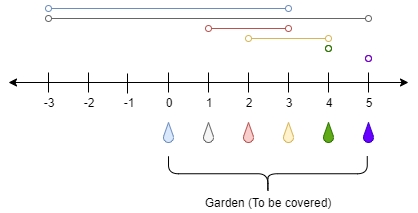16. Minimum Number of Taps to Open to Water a Garden
There is a one-dimensional garden on the x-axis. The garden starts at the point 0 and ends at the point n. (i.e The length of the garden is n).
There are n + 1 taps located at points [0, 1, ..., n] in the garden.
Given an integer n and an integer array ranges of length n + 1 where ranges[i] (0-indexed) means the i-th tap can water the area [i - ranges[i], i + ranges[i]] if it was open.
Return the minimum number of taps that should be open to water the whole garden, If the garden cannot be watered return -1.
Example 1:

Example 2:
Example 3:
Example 4:
Example 5:
Solution: (DP)
Time Complexity: O(n * time)
Solution: (Greedy)
Last updated
Was this helpful?